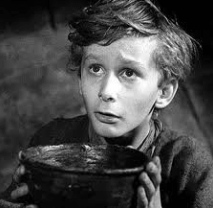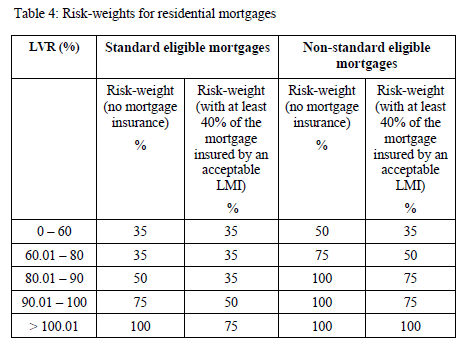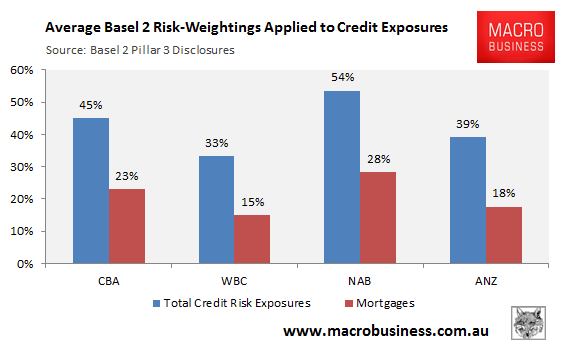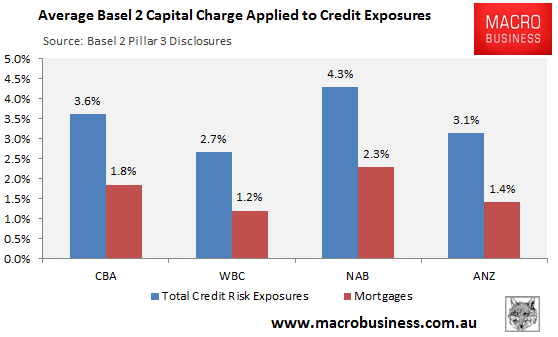
Bank of Queensland (BoQ) chief, Stuart Grimshaw, has urged the Federal Government to boost competition in the home loan market, claiming that the bank capital rules are unfair, since they enable the Big Four banks to hold far less capital than smaller deposit-taking institutions. From the AFR:
…the government’s planned inquiry into the financial system should do more to level the playing field by re-considering rules that require smaller banks to hold higher amounts of capital in reserve when they lend to home buyers.
“At the moment, the playing field is very steep, and getting it a little bit more level would be good,” he said.
“If you went and got a loan from a major bank and then got a loan from us, we have to put three times more capital aside for that mortgage than a major bank does. It’s the same person, the same mortgage, but a different bank”.
…BoQ’s “risk systems aren’t the same as the major banks”, but the “three times capital differential” was not warranted.
“We certainly think the federal government’s proposed inquiry into the financial system should look at such inequities and give the regional banks and smaller financial institutions that chance to describe the imbalance that exists,” Mr Grimshaw said.
I have some sympathy for BoQ’s position. Under the Basel bank capital rules, smaller authorised deposit-taking institutions (ADIs) – i.e. smaller banks, building societies, and credit unions – are required to use APRA’s Standardised Approach to managing credit risk, which ascribes a minimum risk-weight of 35% on mortgages, or a 2.8% capital charge (i.e. 0.35% times 8% capital charge). This means that for every $100 of mortgage lending on qualifying mortgages, these ADIs must hold $2.80 in capital (see below table).

By contrast, the Big Four banks (and Macquarie) have been accredited to use their own internal systems to calculate their capital charges, and therefore fall under APRA’s Advanced Internal Ratings-Based (IRB) Approach. Under these IRB models, the Big Four’s capital charge on their total residential mortgage books ranges from only 15% to 28% [note: these risk weights include both low and higher risk mortgages]:

As such, the average capital charge applying to the Big Four’s mortgage books are only between 1.2% and 2.3% – well below those applying to the smaller ADIs (see next chart).

For anyone wanting to know why the Big Four’s profits are so big, above is the smoking gun. The minimal capital requirement on mortgages allows the Big Four to leverage-up their mortgage books 2.4 times higher than other ADIs, meaning they earn returns on equity that are a whopping 2.7 times better than their competitors.
To make matters worse, the Big Four banks are also way too big to fail, requiring the taxpayer (you and I) to implicitly guarantee their operations. This implicit subsidy – which provides the Big Four with a two-notch upgrade to their credit rating – also lowers their cost of funds, boosting their profits even further.
The goal of regulators should not be to level the playing field by allowing smaller ADIs to leverage their mortgage books 60-plus times, as applies to the Big Four. This would further increase overall risk in the financial system and potentially place taxpayers at risk of even greater losses down the track in the event that the financial system imploded (assuming financial contagion ensued).
Rather, given their “too-big-to-fail” status, the goal should be to address the imbalances in bank capital by increasing the Big Four’s capital requirements to more closely reflect those of the smaller ADIs.
The adequacy of the Big Four’s capital, their too-big-to-fail status, and the taxpayer’s implicit guarantee should be a key focus of any new financial system inquiry, in order to reduce risks to financial stability and moral hazards imbeded in the system.

